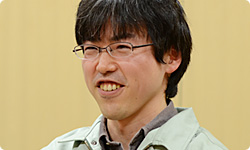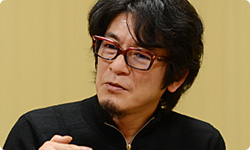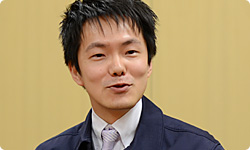So how did you find a solution?
Well, production of Fire Emblem: Shin Monsho no Nazo neared the end without us ever finding a solution and then it was time to decide upon the next story. I proposed to Higuchi-san and Maeda-san that instead of a complete departure, we could make an amalgamation of all the Fire Emblem games so far – and their eyes lit up. (laughs) The idea that resulted became the basis for this game.
(Editor’s note: An amalgamation is the process of combining multiple entities into a single form; in this case, combining all the best pieces of previous Fire Emblem games into a new title)
Were you aware that your eyes lit up?
Yes. (laughs) An amalgamation was easy to think about, so the plan came together in about a month.
But aiming for an amalgamation wouldn’t solve everything, would it? I would think that when it came to deciding what is good about each installment of the series, opinions would be split. Was that true?
Yes. There were all sorts of opinions and we even performed a survey of all company employees. As a result, we decided that liking the characters is what’s most fun about Fire Emblem and were able to combine the best parts of each title.

Yokota-san, were you fairly involved in the process of pulling that together?
Yes. All of a sudden.
When Yokota-san, a Fire Emblem fan, showed up, did you all think, “Now here’s a director who knows his stuff!” (laughs)
We were really thankful! (laughs)
We were on the same wavelength. The gears synced up as soon as we started moving and turned right up to the end.
He knows all the previous works, so it was great how we were able to easily share sentiments like “It would be cool if we combined this element with this one.”
It made an impression on me how we exchanged opinions in such a positive way, so it was really enjoyable. (laughs)
I feel like once we got started, we did it all at once.
I suppose that’s because what we made was the ultimate amalgamation.
What exactly does the “ultimate amalgamation” mean?
As you pointed out, various opinions arose in pulling together an amalgamation, but we were like, “To achieve our goal, let’s just put in everything!” And the power of the development team achieved all kinds of things. We hardly wavered, so we were able to surpass an amalgamation to pull off the ultimate amalgamation.

When you add lots of elements, you end up battling with ones that contradict each other. Just putting them all into a single set of game mechanics multiplies the number of things you have to fix. But the team cruised along as if they were nothing?
Yes. Because of their power, they were able to react to and solve all sorts of things.
For example, take individual on-map units.5 We assumed that it was enough to be able to tell what kind of fighter they were, but the section in charge of them had a strong opinion about it and said “Since we’ve got a system in which you can be all kinds of different types of character, let me change the faces on the map for each one!” Just that alone would cause the amount of work required to jump up, but we were like, “All right, let’s do it!”5. On-map units: Icons on the map that represent the various characters.
You kept expanding the amount of work, but moved forward with a positive attitude.
Yes. Work kept bubbling up, but we had a kind of power and said, “We’ll take it all in!”
And that’s why Narihiro-san, who was watching from the sidelines, thought it wasn’t an amalgamation so much as the ultimate amalgamation.
Right. (laughs) Looking at it objectively, I was worried about whether they could pull off so much volume, but they got through it and achieved the ultimate amalgamation.
Everyone on the team said, “I want to put this in!” and “If we did this, it would be more fun!” And they actually did it, so the project grew rapidly in both size and how enjoyable it was.
A big theme this time is love for the characters, so I’m glad we were thorough about it. We can’t be certain that every player will see everything, but if some at least think, “Oh, they put in a visual for this, too,” then their affection for the characters will increase.

You were even thorough about places that only a few players might pay attention to.
Yes. Another theme this time is bonds, so we wanted to express the ties between comrades through the mechanics by putting in a duel system in which you fight co-operatively with nearby comrades . At first, two characters won’t be very strong, but as they come to get along better, they’ll get stronger.
That didn’t exist before, giving rise to a difficult problem with regard to overall balance.
Yes. We wondered if perhaps two-on-one combat was taboo in Fire Emblem. But an opponent who doesn’t have the concept of bonds can’t team up with anyone, which works out well for the player, so we put it in. Besides, I think various styles of play will arise, with some enjoying having characters who fight alongside each other, while others may have them fight separately.
And the tempo of battle improves. I always tend to attack before thinking, so I’m always in danger, but if you put a character beside me who’s attacking on his own, I feel like I want to fight along with him instead. You’re conscious of such ties as you play, so I thought it was a great system.
Oh, I see. The duel system strengthens your emotional involvement with the characters.
And the characters talk during battle, which might create a greater attachment to them.
Yes, another characteristic of this game is the voiceovers .
We thought giving the characters voices would make them easier to imagine and having voiceovers was a matter of course, so I think we naturally settled on that. (laughs) But if you go with full voice, the amount of data increases a lot and we wanted to pay attention to the pace of conversation, so this time we went for rapid-fire lines that would evoke an atmosphere.
Because it’s an all-new game, we put in everything we could. We used some eminent voices, so players may think, “Oh, this character is performed by that one voice actor!”
Even if it isn’t a boy and a girl?
Well, it’s about love. (laughs)
I guess the themes are love and bonds! (laughs)
© 2024 Nintendo.